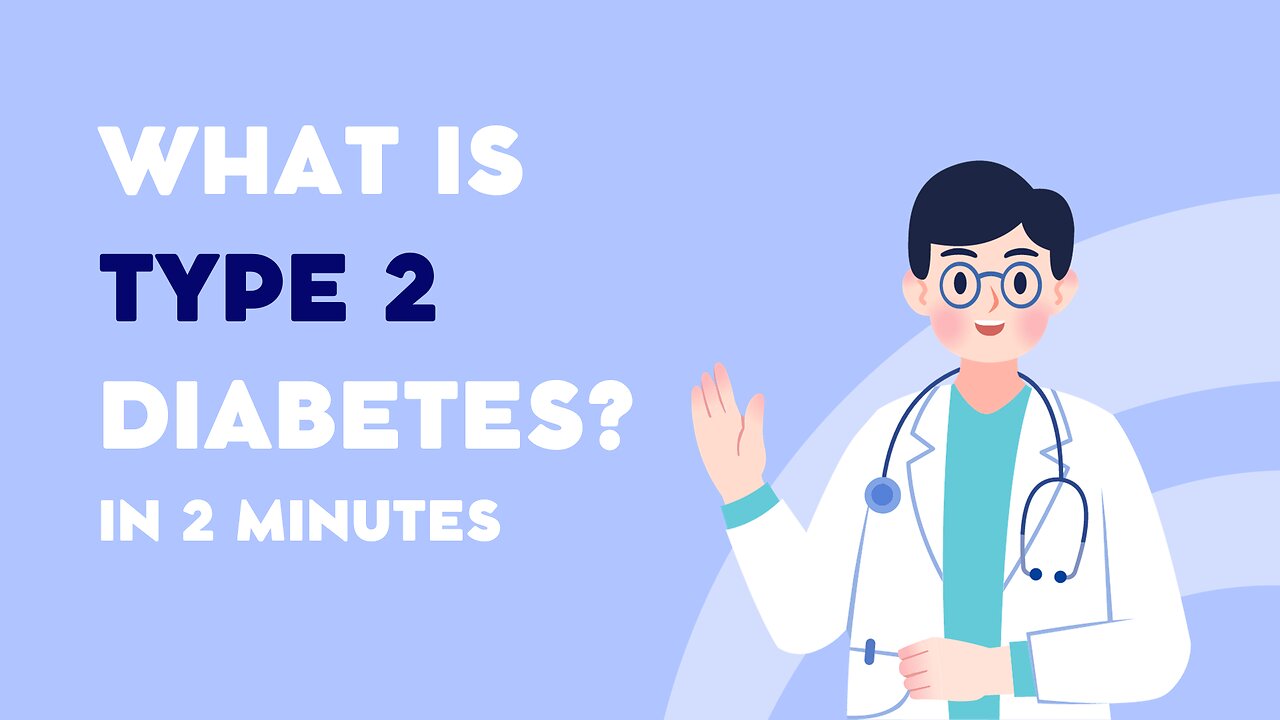Premium Only Content

What Is Type 2 Diabetes? | 2 Minute Guide
Type 2 diabetes, also known as "adult-onset diabetes" or "non-insulin-dependent diabetes," is a chronic metabolic disorder characterized by high blood sugar levels (hyperglycemia). Unlike Type 1 diabetes, where the body does not produce any insulin, Type 2 diabetes involves insulin resistance and relative insulin deficiency. Here are key features and characteristics of Type 2 diabetes:
Insulin Resistance: In Type 2 diabetes, the body's cells become resistant to the effects of insulin. This means that even though the pancreas may produce insulin, the cells don't respond to it effectively. As a result, glucose cannot enter the cells, leading to elevated blood sugar levels.
Gradual Onset: Type 2 diabetes typically develops gradually over time. It is more common in adults, although it can occur in younger individuals as well. Risk factors for Type 2 diabetes include obesity, physical inactivity, family history of diabetes, and certain ethnic backgrounds.
Symptoms: Symptoms of Type 2 diabetes may include increased thirst (polydipsia), frequent urination (polyuria), unexplained weight loss, extreme hunger (polyphagia), fatigue, blurred vision, slow wound healing, and recurring infections. Some people with Type 2 diabetes may not experience noticeable symptoms, and the condition may be discovered during routine medical check-ups.
Blood Sugar Management: Managing blood sugar levels in Type 2 diabetes involves various strategies. These can include lifestyle modifications such as adopting a healthy diet, increasing physical activity, losing weight (if overweight or obese), and possibly using oral medications or insulin therapy as prescribed by a healthcare provider.
Complications: If not managed properly, Type 2 diabetes can lead to a range of complications, including heart disease, stroke, kidney disease, eye problems (retinopathy), nerve damage (neuropathy), foot ulcers, and circulation problems. Proper blood sugar control and regular medical check-ups can help reduce the risk of complications.
Treatment: Treatment for Type 2 diabetes is individualized and may involve lifestyle changes and medications. Oral medications, such as metformin, and other medications that improve insulin sensitivity or stimulate insulin production, may be prescribed. In some cases, insulin therapy may be necessary.
Lifestyle Management: Lifestyle modifications are a crucial part of managing Type 2 diabetes. A balanced diet, regular exercise, weight management, and blood sugar monitoring are important components of a diabetes management plan.
Prevention: Type 2 diabetes can often be prevented or delayed through lifestyle changes and risk reduction. Maintaining a healthy weight, eating a balanced diet, staying physically active, and avoiding tobacco use are key preventive measures.
It's important to note that while Type 2 diabetes is more common in adults, the increasing prevalence of obesity and sedentary lifestyles has led to a rise in the diagnosis of Type 2 diabetes in children and adolescents as well. Regular medical check-ups and early detection are essential for effective management and prevention of complications.
-
 LIVE
LIVE
Tundra Tactical
5 hours ago $0.04 earned🎯💥 The World’s Okayest Gun Show 🔫😂 | LIVE Tonight on Rumble!
164 watching -
 3:36:03
3:36:03
Mally_Mouse
1 day ago🌶️ 🥵Spicy BITE Saturday!! 🥵🌶️- Let's Play: Tower Unite!
30.1K1 -
 58:59
58:59
MattMorseTV
5 hours ago $0.95 earned🔴Trump just BROKE Newsom.🔴
49.3K54 -
 18:14
18:14
Her Patriot Voice
5 hours agoWho Is WORSE for NYC: Trump Girl or Socialist?
24.2K23 -
 3:39:42
3:39:42
SavageJayGatsby
5 hours agoSpicy Saturday with Mally! | Road to 100 | $300 Weekly Goal for Spicy Bites!
31.3K1 -
 LIVE
LIVE
FomoTV
7 hours ago🚨 Swamp Theater: FBI Raids Bolton 🕵 Still NO Epstein Files, Trump's Troops & the Red Heifer Hoax 🐂 | Fomocast 08.23.25
64 watching -
 6:04:40
6:04:40
Akademiks
10 hours agoRoc Nation & Meg Thee Stallion did a 7 HOUR Deposition with me. Drake Secret Kid Finally Revealed.
49.9K2 -
 24:19
24:19
Stephen Gardner
6 hours ago🚨BREAKING: FBI Raid of John Bolton’s House Reveals THIS!
51.9K126 -
 8:31
8:31
MattMorseTV
8 hours ago $1.10 earnedTexas just did the IMPOSSIBLE.
46.2K60 -
 24:39
24:39
MYLUNCHBREAK CHANNEL PAGE
1 day agoInterdimensional Beings at Borobudur
54.6K29